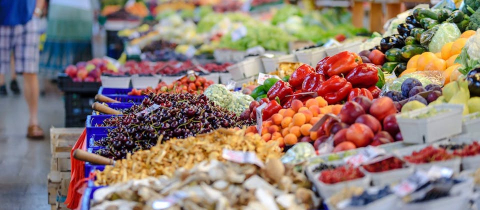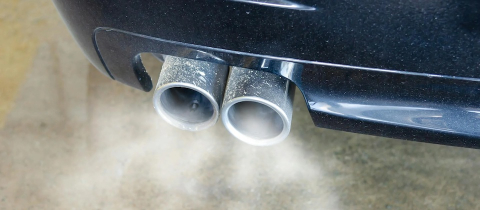Like most chemists, I like to cook. After all, what is cooking but the appropriate mixing of chemicals? In the lab we use flasks and beakers, but how do we equip our kitchen? Tiffany's in New York offers a silver frying pan for thousands of dollars, specialty stores sell gleaming copper pots for a couple of hundred while a thin aluminum pot can be had almost anywhere for a few bucks. What's the difference?
A gourmet cook will describe with a trembling voice how hot spots on the bottom of a pot can destroy the most delicate sauce. Efficient heat conduction and precise heat control are needed to avert this tragedy. Silver fits the bill in an ideal fashion but of course, is very expensive. Copper conducts heat almost as well, however it can dissolve in food and cause nausea, vomiting and diarrhea.
Copper cookware is usually lined with tin or stainless steel to avoid such problems. This lining eventually wears off and requires replacement. There are also aluminum or steel pans with a thin layer of copper on the bottom but this amount of copper is not enough to improve the heat conduction of the pan.
Aluminum itself is an excellent conductor. In fact, more aluminum cookware is sold than any other type. But some cooks have discarded their aluminum pots and pans because of reports linking aluminum with Alzheimer's disease. Most researchers today do not believe that aluminum is a causative factor in Alzheimer's and in any case, the casting away of the cookware is to no avail.
Most such cookware is coated with a non-stick finish but even if someone were to use uncoated aluminum for all their cooking and for all their food storage, they would ingest only about 3.5 milligrams of the metal every day from this source. Compare this with the roughly 20 milligrams which are consumed daily as a natural component of food or to the 1000 milligrams found in a daily dose of an antacid for an upset stomach. A single buffered pain reliever contains more than 10 milligrams of aluminum.
To put our minds completely at ease, it may be a good idea to avoid cooking or storing highly acidic or salty foods in uncoated aluminum pots for long periods. Tomato sauce, rhubarb and sauerkraut would fall into this category. In fact, a good general rule is to store food in the refrigerator in glass containers and not in pots or pans.
Even though this represents no danger, aluminum pots will sometimes discolour as a result of reacting with food. Simmering for fifteen minutes with a solution made by dissolving a couple of spoons of cream of tartar in a litre of water usually restores the finish.
A new kind of aluminum cookware, made of "anodized aluminum" has recently been introduced. It is usually gray, harder than stainless steel, conducts heat better and is eternally nonstick, scratch-resistant and easy to clean. The process of "anodizing" involves passing the aluminum through a series of electrochemical baths which cause the formation of a hard layer of aluminum oxide on the surface. This layer is unreactive and does not leach aluminum into food.
The traditional nonstick coating has of course been Teflon, discovered accidentally in 1938. This inert substance does not react with food in any fashion. Words of comfort to anyone who has ever worried about swallowing bits of Teflon coating which may flake off older cookware! The perfluorocarbon resin passes through the body unchanged.
Teflon may release some toxic vapours if heated to high temperatures for long periods. While this represents little risk to humans, there have been isolated reports of pet birds being overcome by such kitchen fumes.
Just as Teflon cookware connotes modern times, cast iron symbolizes traditional cooking. This metal is a good conductor of heat and since small amounts dissolve in food, it even serves as a dietary source of iron, one of the few nutrients in short supply in the North American diet.
Cast iron cookware should be "seasoned" to prevent rusting and food adherence. This is done by coating the pan with a thin layer of oil and then heating it. The oil reacts with oxygen to form a tough, smooth, impervious layer.
Stainless steel is made by alloying iron with other metals, most notably nickel and chromium. It is durable and does not tarnish. The heat conduction, in general, is not even and therefore most stainless steel cookware is made with aluminum or copper bottoms. Some nickel may leach into acidic foods like applesauce and may present a problem especially to people with nickel allergies. Chromium is not a concern because most of us could probably use a little more of this mineral in our diet.
To minimize leaching, steel can be coated with porcelain to give enamelled cookware. The finish is stain and scratch-resistant and is perfectly safe. No lead is used in the manufacture of such glazes. Lead may be used in glazes destined for slow cooking such as "crock-pots," but the manufacturer has to provide evidence that no leaching of the metal occurs. The stories which make the rounds about lead poisoning from ceramic ware invariably involve improperly manufactured items.
A classic story is told about a California family which suffered acute lead poisoning from drinking orange juice stored in a ceramic pitcher purchased in Mexico. At first, no one was able to diagnose the condition. The doctors advised leaving the house just in case the problem was environmental. When the family left, the symptoms disappeared. When they returned to the house, the symptoms reappeared. This cycle repeated several times until they called in a chemist who immediately recognized the lead glaze on the pitcher in the refrigerator and solved the problem. Obviously, they should have consulted a chemist sooner.
So what is the best cookware? Of course, it depends on one's personal preference and pocketbook. Trained French chefs worship copper. But for us ordinary kitchen chemists, a stainless steel pan with a thick aluminum bottom can serve just fine. Anodized aluminum is also excellent. Nothing sticks to it, it cannot be scratched and requires virtually no cleaning. And as far as concerns about Alzheimer's disease go, I've been cooking in aluminum pots all my life and I can't remember any problems!







